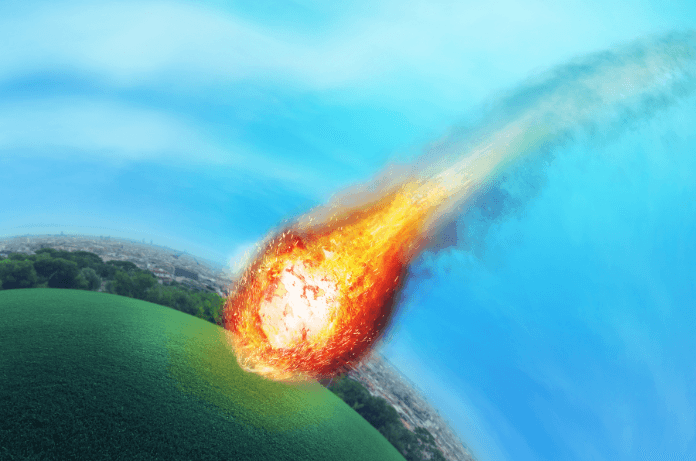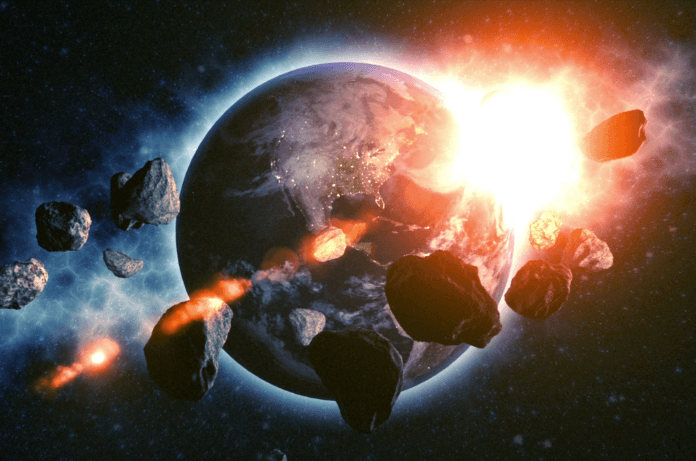Imagine a time when Earth was a young, volatile planet, just beginning its journey of transformation from a barren rock to a thriving habitat for life. Now rewind the clock back 3.26 billion years, Known as S2, this colossal space rock is estimated to be four times the size of Mount Everest and is believed to have significantly impacted Earth’s oceans long before dinosaurs, trees, or even complex organisms existed. Earth was a completely different place, yet it faced a cosmic event that would change its history, a massive meteorite impact.
This impact may have been one of the critical events that set the stage for the development of early life.
In this blog, we will dive into this ancient cataclysm and explore how it could have influenced the emergence of life on our planet.
The S2, thought to be up to 200 times larger than the asteroid that led to the extinction of the dinosaurs, unleashed a colossal tsunami that stirred the oceans and brought terrestrial debris into coastal regions.

The intense heat generated by the impact caused the ocean’s surface layer to boil away, significantly raising atmospheric temperatures.
A dense cloud of dust enveloped the planet, effectively blocking sunlight and halting any photosynthetic processes occurring at the time. This catastrophic series of events drastically altered the planet’s ecosystems.
The Great Meteorite Impact: What Happened?
3.26 billion years ago, a giant meteorite, estimated to be over 20 miles (32 km) wide, struck Earth. To put this in perspective, the asteroid that wiped out the dinosaurs 66 million years ago was about 6 miles (10 km) wide and this ancient meteorite was over three times larger!
The Impact of S2: A Game-Changer for Early Earth
Introduction to S2’s Discovery
Discovered in 2014, the S2 impactor collided with Earth during the Paleoarchean Era, a period characterized by a water-dominated planet with minimal land. This cataclysmic event created a colossal crater, measuring 500 kilometers in diameter, and unleashed pulverized rock into the atmosphere, forming a global debris cloud. According to Nadja Drabon, a geologist at Harvard University and lead author of the study, “Imagine a rain cloud, but instead of water droplets, it’s like molten rock droplets raining out of the sky.”
Extreme Conditions Post-Impact
The collision resulted in drastic environmental changes, with air temperatures rising by up to 100 degrees Celsius and ocean waters evaporating by several meters. This evaporation blocked sunlight and led to the near extinction of surface-dwelling photosynthetic life.
Favorable Conditions for Early Life
Despite the devastation, researchers suggest that the aftermath of the impact may have created conducive conditions for early life. They hypothesize that the tsunamis generated by S2 stirred essential nutrients from the deep ocean and especially iron and phosphorus into coastal regions, effectively acting as a “giant fertilizer bomb” for emerging life forms.
Field Research and Findings
To explore the implications of the S2 impact, scientists conducted field research in South Africa’s Barberton Greenstone Belt, collecting nearly 100 kg of rock samples for analysis. Their findings revealed that the violent disturbances caused by the meteorite released critical nutrients that facilitated the rapid recovery and proliferation of microbial life. According to Nadja Drabon, a geologist at Harvard University and lead author of the study, “It seems that life after the impact actually encountered really favorable conditions.”
A Cosmic Spark for Life?
The idea that a massive meteorite impact 3.26 billion years ago could have contributed to the development of life is a fascinating window into Earth’s ancient history. While it may seem paradoxical that such a destructive event could pave the way for life, the impact likely created conditions that were ideal for the birth of simple organisms. From hydrothermal vents and nutrient-rich oceans to warm, shallow seas, the aftermath of this cosmic collision may have been just what Earth needed to transition from a lifeless planet to one teeming with potential.
This story reminds us of the complex and interconnected nature of our universe. It shows how life can emerge from the most unexpected places, even from the chaos of a massive impact.
And while the mysteries of Earth’s early days continue to intrigue scientists, one thing is clear: sometimes, it takes a little cosmic disruption to create the perfect conditions for life.

